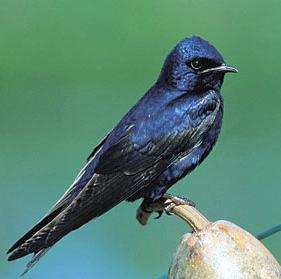Description
The perfect home for colonizing martins!
We make a habitat for every species of cavity nesting bird in North America. All of our products are correct for the species, easy to clean, well insulated and provide for the proper drainage. Every house includes an educational brochure specific to the species.
In the East, Purple Martins are attracted to houses with multiple apartments to establish colonies. This house opens on four sides for easy cleaning and mounts securely on a pole.
This unique Purple Martin House is designed for a bird which, while it lives in colonies, is quite territorial. Therefore, each "apartment" is separated from the rest. In other designs with several holes in a row, martins will occupy only every other room, unless it is overly crowded. This house's separation helps ensure the survival of the young, and the wooden floors give them a secure footing. The eight "apartments" are side-opening for easy cleaning. Center core of house slips over a 1.75" pipe or telescoping pole. Quality eastern white pine construction. Made in the USA!
Purple Martin House Dimensions:
17"h x 16-1/2"w x 16-1/2"d; Weight: 30 lbs.
Openings: 2" dia.
Apartment Size: 6"W x 5"D x 6"H
Mounting: pole mount
Note: Ships dimensional oversized. Additional freight may be required depending on order size and destination zone.


The Purple Martin is the largest of the North American swallows. Purple Martins are a migratory species that breeds along the West Coast and in the eastern and central portions of the United States, and in parts of Canada and Mexico. While martin populations have grown in the East, their numbers have declined in the middle of the United States. This species nests in open and semiopen areas, including savannas, cultivated lands, fields, parks, pastures, near lakes and marshes and in towns and suburbs. Purple Martins can reach fairly high densities when martin houses are present.
One of the major reasons people fail to attract Purple Martins is that they place the martin housing incorrectly. Martins have very specific space requirements. Their housing should be in the center of the largest open spot available, about 30-120 feet from human housing. Place the housing where you can see it so you can enjoy watching and hearing the martins. There should be no trees within 40 feet, preferably 60 feet. In the southern half of their breeding range, martins are less fussy about house placement, so sometimes housing can be within 25 feet of trees and still attract martins. But the farther housing is placed from trees, the better. Housing height should be about 10-15 feet. Don’t attach wires to the house or pole, especially if they lead to trees, buildings, or the ground. Predators can use the wires to access the housing.
The breeding season begins in late March in the southern part of the range, but not until late May or early June in the northern parts. (In Florida, however, nest building can begin as early as February.) As with many native cavity-nesting species, Purple Martins compete with House Sparrows and European Starlings for nest sites. In many regions, such as the eastern United States, martins are extremely dependent on human-provided martin houses. In the West, however, Purple Martins nest more frequently in natural sites, such as abandoned woodpecker holes, cliff crevices, and in the cavities of oak, sycamore, ponderosa pine and spruce trees.
Attracting Purple Martins
To attract Purple Martins to a birdhouse, the house should be placed in an open space, at least 40 to 60 feet from any trees taller than it is, preferably within a few hundred feet of human habitation. The birds need a wide space to approach the house from at least two sides, and they seem to know that people will protect them from their natural predators. The activity of people does not seem to bother them at all. The house should be mounted 10 to 20 feet off the ground, preferably on a telescoping pole so that it can be lowered for easy cleaning and for checking on the young in the nests. A predator guard on the pole is also highly desirable. The house should not be moved, once martins have taken up residence in it, as they will reject it the following year if it is in a new location. If any other species of bird nests in the martin house before the martins arrive, the house will not attract martins. This may involve frequent, even daily, lowering of the house to evict unwanted tenants, or plugging the entrance holes until the martins arrive. The houses which are most successful in attracting martins are of a light color. This helps to keep the house cool in the summer's heat and highlights the dark entrance holes. Ventilation holes also keep the birds from perishing on hot days. The birdhouses should not be opened up until about four weeks after the first martins are scheduled to arrive in the area. The first to arrive, commonly called "scouts," are not really scouts, but are merely the oldest martins. Older martins cannot be attracted to new locations, because they have high loyalty to the exact home where they bred in the past. Usually only the previous year's fledglings can be attracted to unestablished sites, and they begin returning to an area about 4 to 5 weeks after the "scouts."